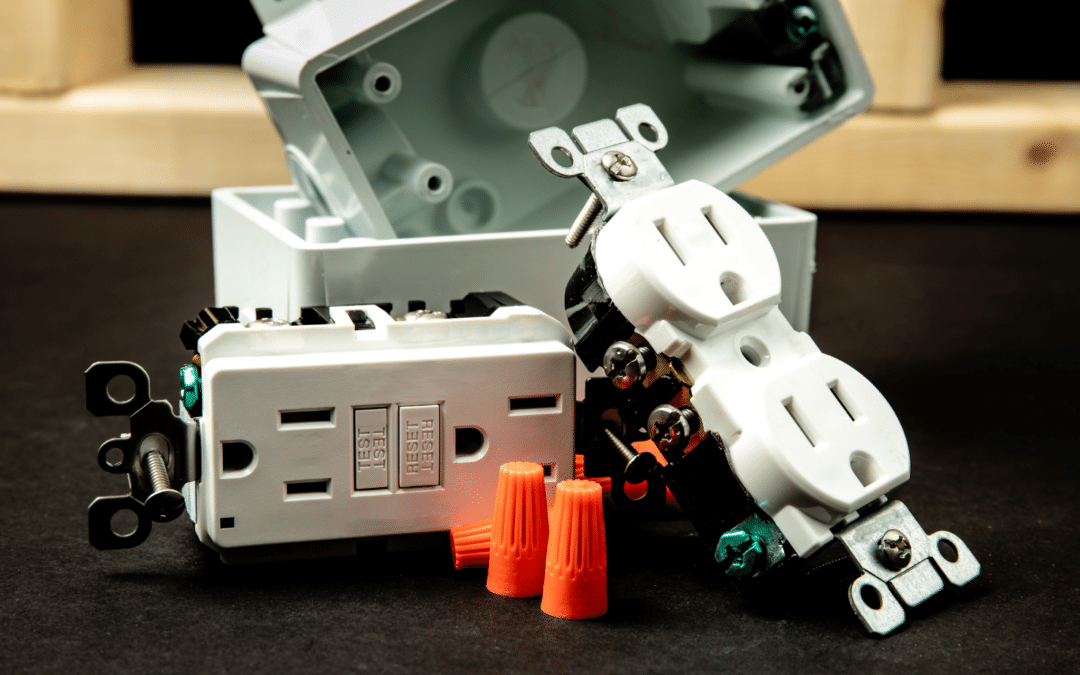As a homeowner or a watcher of old mystery movies, you probably know that water and electricity don’t mix. What you may not know is that modern household electrical outlets are specially designed to keep you and your property safe from electrical mishaps.
The outlets in your bathroom and kitchen—or anywhere electricity and moisture are in proximity—are ground fault circuit interrupters (or GFCIs), and they feature “test” and “reset” buttons. What exactly does this mean, and what are those buttons for?
What is a GFCI?
First, let’s explore what GFCIs are. In our article GFCI or AFCI: What Are They and Which One is Right for You, we took a deep dive on the topic.
The bottom line that you need to know is that electrical current always follows the path of least resistance on its way to ground. When electricity strays from its intended path because it finds a better conductor such as water, a GFCI device protects against a ground fault. It does so by automatically detecting anomalies in the flow of electricity and killing the flow of electricity if it senses danger, a process that happens in milliseconds.
Because the main cause of ground faults is moisture or water in the outlet, GFCI devices are required in any areas prone to moisture or the possibility of getting wet like bathrooms and kitchens.
Other examples of where GFCI outlets are required include:
- Outdoor outlets, like on a porch or deck
- Pool houses
- Laundry rooms
- Unfinished basements
A GFCI outlet is an important safety feature in a home because if stray electricity encounters you or something you touch that has been energized, you’ll receive an electric shock, which could be deadly.
What Do the Test and Reset Buttons Do?
The test and reset buttons on GFCI outlets are designed to ensure that the outlet is in good working condition. Although modern outlets continually monitor themselves, it’s still a good idea to test them occasionally to ensure they work.
To test the GFCI outlet, simply push the test button in for five seconds. The outlet should lose power and the reset button should push out. This means the GFCI is working properly. Press the reset button back in, and you’re ready to use the outlet.
If an event occurs that trips the GFCI outlet—such as an overload on the circuit (think of plugging in a hair dryer and space heater at the same time)—the reset button allows you to get electricity flowing again after correcting the problem.
To reset the circuit, unplug everything from the outlet and press the reset button. You should then be able to resume using the outlet. If the reset button pops back out again as soon as you press it, you may need to replace the outlet or call an electrician to do so.
What If the Test Button Doesn’t Work?
If the reset button doesn’t pop out when you press the test button, the unit isn’t working properly and you must replace it. Ideally, it’s a good practice to test your GFCI outlets monthly and replace them every 10 years. Over time, GFCI outlets can wear out and become less effective at detecting electrical faults.
Installing or Replacing a GFCI Outlet
As we wrote in our article 5 Common Electrical Mistakes DIYers Make, failing to install GFCI outlets near water is a common error. So first, be sure these safety feature outlets are installed in any place that is near moisture. It is now a requirement for modern homes according to local building codes and the National Electric Code (NEC), but older homes may not have converted from the two-prong outlet.
If you find any of the following issues with a GFCI, it may need to be replaced:
- The outlet is not working
- The outlet is tripping frequently
- The outlet is warm to the touch
- The outlet is discolored or damaged
If you are comfortable doing electrical work yourself, you can replace the GFCI outlet. Check out the article How to Replace a GFCI Outlet in 7 Steps for a quick overview of how to do it, which includes:
- Turning off the power at the circuit breaker
- Removing the faceplate and unscrewing the outlet from the electrical box
- Disconnecting the wires from the old outlet and reconnecting them to the new one
- Securing the new outlet into the electrical box and attaching the faceplate
- Returning power to the outlet and testing it
However, if you are not comfortable with electrical work, hire a licensed electrician for the job.
How Can Shockley Electric Help?
At Shockley Electric, we address important home safety issues such as power surges, faulty electrical wiring, and potential fire hazards when we do electrical preventive maintenance in homes or commercial buildings.
We are licensed, trained, and skilled in safety-proofing your home, and we are committed to the safety and well-being of our customers.
If you are experiencing electrical problems in your home or aren’t sure if your home is protected from electrical hazards, schedule an in-home estimate or appointment with us today. Fill out our form or call us now for a free estimate!

